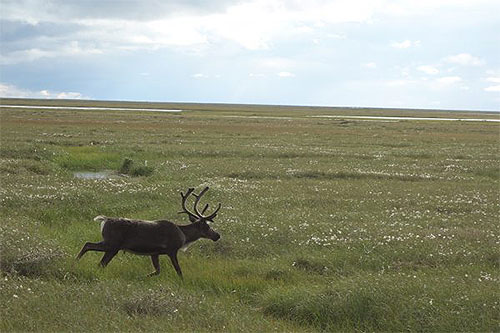Alaska Science Warming in the North continues as predictedBy NED ROZELL
June 23, 2018
A few days ago, John Walsh gave a talk a few hundred steps from that parking lot. Walsh has spent 17 years in Fairbanks studying Arctic climate and learning about the latest physical changes in the far North. He is the chief scientist of the International Arctic Research Center, and an expert on global warming as it applies to the Arctic and sub-Arctic.
Back in the parking lot, an engineer guiding the work watches the drillers hit clear discs of ice, about 7 feet below car level. The ice had been solid for centuries, maybe thousands of years, but the construction of a parking lot in the late 1990s is making it shrink. What used to be spruce trees and an insulating carpet of forest floor is now a layer of warm asphalt. Human-assisted or not, thawing permafrost is a slow-motion disaster happening now in most of northern Alaska. Unlike a hurricane or a flood, the loss of permafrost is silent, rarely dramatic, and never fatal. In the back parking lot, university secretaries and grounds crew workers will steer into different parking spaces, and go on with their days. Even though they are dramatic in scale, the northern changes Walsh described have the same subtlety. They happen far from where most people live and have not yet resulted in an emergency for most of the world’s billions. For example, sea ice was just not there in the Bering Sea and Arctic Ocean this spring. “That was new territory for open water,” Walsh said. In the recent history of Earth, blue water on the northern oceans in early spring was an event worthy of more than a few minutes of Twitter’s attention. But few people heard that ocean lapping outside Point Hope and Utqiagvik. Lack of reflective sea ice floating on the northern oceans might help nurture 30-inch rainfalls in Houston, Texas, but that connection is hard to prove. There is also a confusing normalcy that interrupts the global warming narrative. Northern temperature trends that have climbed upward since the mid-1970s are indisputable, but have been skewed by what Walsh and other scientists call “internal variability.” A remembered example is January 2012, when the Fairbanks average daily temperature was minus 26.9 F, 19 degrees colder than the long-term average. Cold months make people think things are the same as they always were, but “the dice are loaded toward the extremes that go with warming,” Walsh said. Those daily dramas include more rain in wintertime, less and thinner sea ice, shorter winters, and flash floods that wash out Alaska highways. The ice that coated and broke spruce trees in my yard after a January 2018 rainfall is hard to pin on carbon levels in the atmosphere. But repeat enough unusual events and people may equate historic levels of carbon dioxide to weird, sometimes threatening conditions. “One of the ironies is that it takes a disaster to wake people up,” Walsh said, noting that climate researchers in Canada got a funding bump after a wildfire flashed through Fort McMurray in Alberta, Canada, in 2016. At the end of his lecture, Walsh received a common, difficult question: We believe what you are saying, now what can we do about it? The parking lot might be repaired if workers dug a swimming-pool sized hole to remove all the frozen soil and then replaced it with gravel. Similar repairs will probably cost northerners millions in the years to come. And that’s just the Band-Aid. Reducing the carbon dioxide that is warming the planet takes a worldwide effort. Walsh believes it starts from the bottom up, with people acting to reduce their own carbon emissions. He sees his job as spreading the word of what professionals are observing in the North and what it means for our future. “I tend to look at creating awareness, using our science for a purpose,” he said.
Representations of fact and opinions in comments posted are solely those of the individual posters and do not represent the opinions of Sitnews.
|
||||

